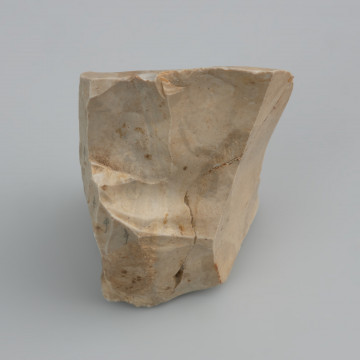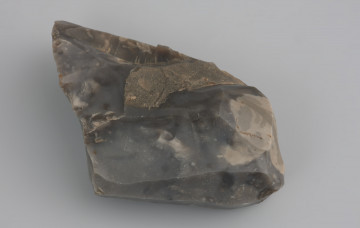
Single-stacked chipboard core
12700 p.n.e. — 11900 p.n.e.
National Museum in Szczecin
Part of the collection: Stone Age
The prismatic core comes from Smolęcin, the Gryfice district. The first reports of finds of flint products in the vicinity of this village date from 1925, when a small collection of flints was found during earthworks, which was later handed over to the local Heimatmuseum in Gryfice. The core was made of chalk flint. It was used to produce curved blades, which were later turned into arrowheads or knives. Its shape is typical of Late Palaeolithic flint manufacture - it has two opposing heels - surfaces that were struck to produce the semi-raw material. However, it was worked with a hard-stone pestle, typical of early Mesolithic flint manufacture. In flint manufacture, the transitional stage between one of the youngest Palaeolithic cultures (Ahrensburg) and the oldest Mesolithic culture (Maglemose) is characterised by a change in technique from soft pestle (e.g., antler) to hard pestle (e.g., stone) impact, as well as the use of different forms of cores and simplified production technology of flint blanks for tool making.
Michał Adamczyk
Author / creator
Dimensions
cały obiekt: height: 7.7 cm, width: 4.5 cm
Object type
lithic core
Technique
hard masher carving, carving
Material
flint, stone
Origin / acquisition method
field research
Creation time / dating
Creation / finding place
Owner
National Museum in Szczecin
Identification number
Location / status

12700 p.n.e. — 11900 p.n.e.
National Museum in Szczecin

12700 p.n.e. — 11900 p.n.e.
National Museum in Szczecin

10800 p.n.e. — 9600 p.n.e.
National Museum in Szczecin
DISCOVER this TOPIC
Museum of King Jan III's Palace at Wilanów
DISCOVER this PATH
Educational path